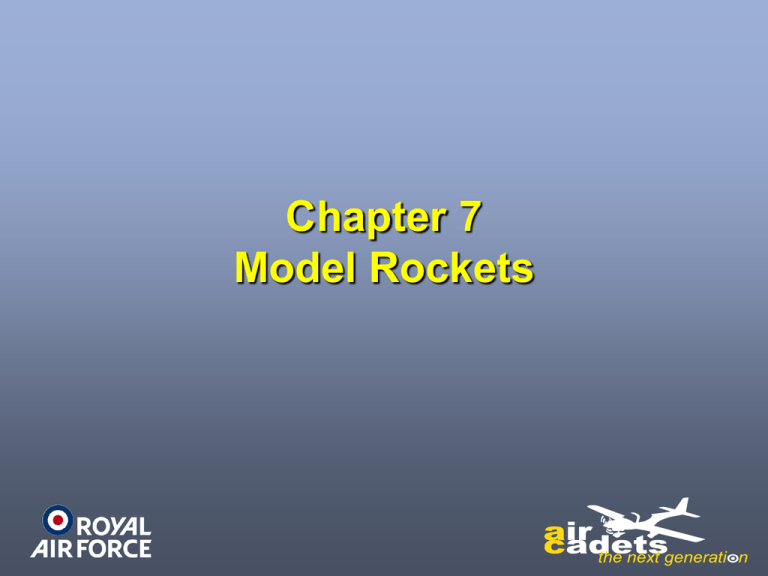Model Rockets
advertisement

Chapter 7 Model Rockets Model Rockets • Model Rockets are a run and inexpensive way of learning about rocketry • Model rockets are not toys but are real rockets • The specialist body for all model rocketry in the UK is the United Kingdom Rocketry Association (UKRA) Model Rockets • Model rockets are real rockets in miniature: – They are launched from a launch pad – The pad supports the rocket while it accelerates – The motors are ignited electrically from a safe distance – The rocket deploys a parachute – Rockets can be flown many times. Model Rockets • The five phases of a model rocket flight are called – boost – coast – ejection – descent – landing. Model Rockets • Boost phase: The motor propels the rocket to its highest speed. • Coast: After the motor has burned all its propellant the rocket continues to move. It coasts upwards, slowing down due to its weight and drag. • Ejection: At the highest point of the flight (called the apogee) a small charge ejects the parachute. • Descent: The rocket drifts back to earth under its parachute. • Landing: The rocket returns safely to earth, ready to be prepared for another flight. Model Rocket Motors • Model rocket motors are similar to real solid rocket motors • The cardboard motor case contains the propellant while it burns • A ceramic nozzle accelerates the exhaust gas • The motor is ignited by passing an electrical current through the igniter – the current heats the wire – this ignites the pyrogen which fires the motor. Model Rocket Motors • 1. The igniter, held in place by a plastic plug, causes a flash of heat which ignites the propellant. • 2. The gas from the burning propellant pushes the igniter and plug out the nozzle. • 3. Hot exhaust gas propels the rocket until the propellant is all consumed. • A delay grain creates tracking smoke while the rocket coasts to apogee. • A small explosive charge fires which ejects the parachute. Model Rocket Motors • Model rocket motors are classified by their impulse • Impulse is the amount of thrust a motor gives (Newtons) multipled by the time for which the motor provides that thrust (seconds) – Impulse = thrust x time • Impulse is measured in Newtonseconds (Ns) • Motors are given a letter which reflect their impulse range Impulse Class Impulse Propellant A 1.26-2.50 Ns BP B 2.51-5.00 Ns BP C 5.01-10.00 Ns BP D 10.01-20.00 Ns BP or AP E 20.01-40.00 BP or AP F 40.01-80.00 AP G 80.01-160.00 AP Model Rocket Motors • A model rocket motor is specified with a simple code: – A letter which denotes the impulse range – A number which is the average thrust provided by the motor (Newtons) – A second number which is the coasting delay (seconds) before the ejection charge is fired Model Rocket Types • They are classified by the overall impulse provided by the motor – Low power rockets (Impulse A to D) – Medium power rockets (Impulse E to G) – High power rockets (Impulse H and above) Model Rocket Types • Low power rockets can fly to altitudes many hundreds of feet. • Motors use solid propellant motors with black powder as the propellant • The picture shows a launch pad with several low power rockets Model Rocket Types • Medium power rockets can fly up to 3000 ft • Motors use solid propellant motors powered by ammonium perchlorate composite propellant (APCP) • The picture shows medium powered rocket (scale model of an AMRAAM missile) Model Rocket Types • High power rockets use large and powerful motors • Solid propellant motors using APCP are common. • Hybrid motors are also used • Rockets can fly to altitudes of over 10,000 ft • Supersonic flights are common • The picture shows a high power rocket, over 2m tall, lifting off for a flight to over 5000 ft Model Rocket Design • The nosecone is the aerodynamic front part of the rocket • The body tube is a strong structure which contains the motor and parachute • Fins ensure that the rocket flies straight • The motor hook keeps the motor in place • The launch lug is used to hold the rocket to the launch rod. • The shock cord holds the nosecone, parachute and body together during descent Model Rocket Design • To prepare a rocket for flight: – insert some flameproof wadding in the tube. This protects the parachute from the ejection charge. – Fold the parachute and pack it into the tube – Place the nosecone into the body tube to hold the parachute in place Model Rocket Design • It’s possible to design your own rockets using specialist software. • The software allows you to – choose materials, – design the shape of the rocket – flight test the rocket with different motors • The software produces graphs and charts to tell you how the rocket performs • Some common software packages are Rocksim, SpaceCad and OpenRocket Getting started • Squadrons can have their own rocketry programme • Squadrons that want to fly model rockets should read ACP 20 ACTI 75 • An inexpensive starter kit can be obtained from your local model shop • You local rocketry club would be happy to help you make your first launch a success









